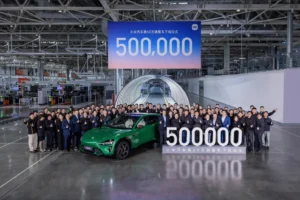Xiaomi’s Growth Challenges: Balancing Expansion & User Focus
Xiaomi’s Future: Navigating Growth Challenges in a Thriving Tech Landscape
Xiaomi, a global tech giant, is experiencing phenomenal growth, reporting record-breaking revenue in Q1 2025. This article delves into the key challenges outlined by Lu Weibing, President of Xiaomi Group, as the company navigates its expansion into electric vehicles (EVs), AI, and beyond. We’ll explore how Xiaomi plans to maintain its user-centric approach while scaling its operations to meet the demands of a rapidly expanding global market.

Preserving Xiaomi’s Core Values in a Growing Empire
Xiaomi’s success story is deeply rooted in its commitment to providing high-quality, affordable products and fostering a strong connection with its user community. This user-centric approach has been instrumental in building brand loyalty. However, as Xiaomi expands its horizons into premium segments with vehicles like the SU7 and the upcoming YU7, maintaining this vital connection becomes increasingly challenging. Balancing global expansion with accessibility and community-driven innovation is paramount. Xiaomi must carefully navigate the expectations of users in higher-priced market segments, ensuring that its core values remain at the heart of its operations. The company must demonstrate that premium doesn’t mean inaccessible.
Scaling Operations for Sustainable Growth: Management System Upgrades
Xiaomi’s second major challenge involves streamlining its management systems to support its rapid growth across diverse sectors, including EVs, AI, and wearables. Xiaomi already holds a dominant 19% global market share in wearables (Q1 2025), highlighting its success. But this diversified portfolio necessitates improved internal efficiency. According to Lu Weibing, internal optimization, rather than direct competition, is the key driver of future success. This involves refining processes to guarantee consistent quality across all product lines. Lu has internally emphasized a zero-tolerance policy for quality issues, reflecting the company’s commitment to its reputation.
Xiaomi’s Financial Performance and EV Ambitions
Xiaomi’s Q1 2025 financial results are impressive, showcasing robust growth. Revenue reached a staggering $16 billion, with a 66% increase in adjusted net profit, reaching $1.5 billion. The EV business, particularly the SU7 sedan, contributed significantly, generating 18.1 billion yuan in revenue with 75,869 units delivered. A recent $5.5 billion fundraising through a Hong Kong share sale will fuel further EV expansion, including the launch of the YU7 SUV, a potential Tesla Model Y competitor. However, a fatal accident involving the SU7 in March 2025 raised concerns about its autonomous driving technology, prompting a thorough internal review and full cooperation with investigations.
Strategic Investments and Future Outlook
Xiaomi’s strategic investments in AI, with a projected 7-8 billion yuan allocated to R&D in 2025, underscores its commitment to technological advancement. The company aims for ambitious targets: delivering 350,000 EVs and 180 million smartphones in 2025. This confidence, however, must contend with external factors such as potential US tariffs and intense competition in the EV market.
Navigating the Risks: Maintaining Momentum
While Xiaomi’s trajectory is undeniably impressive, the challenges outlined by Lu Weibing highlight potential risks. Maintaining brand identity while scaling globally requires careful consideration of cultural and regulatory differences. The SU7 accident underscores the importance of robust quality control and transparent communication to rebuild consumer trust. Xiaomi’s reliance on TSMC for its Xring O1 chip also exposes vulnerabilities in its supply chain. Overcoming these challenges will be crucial for Xiaomi to sustain its leadership position.
Conclusion
Xiaomi‘s remarkable growth is undeniable, but navigating the complexities of global expansion, technological innovation, and maintaining its user-centric philosophy presents significant challenges. Successfully addressing these issues—preserving core values, upgrading management systems, and ensuring product quality—will determine whether Xiaomi can continue its ascent as a global leader in technology and electric vehicles. The company’s ambitious goals and substantial investment demonstrate a strong commitment to its vision, but diligent execution will be key to realizing its full potential.







